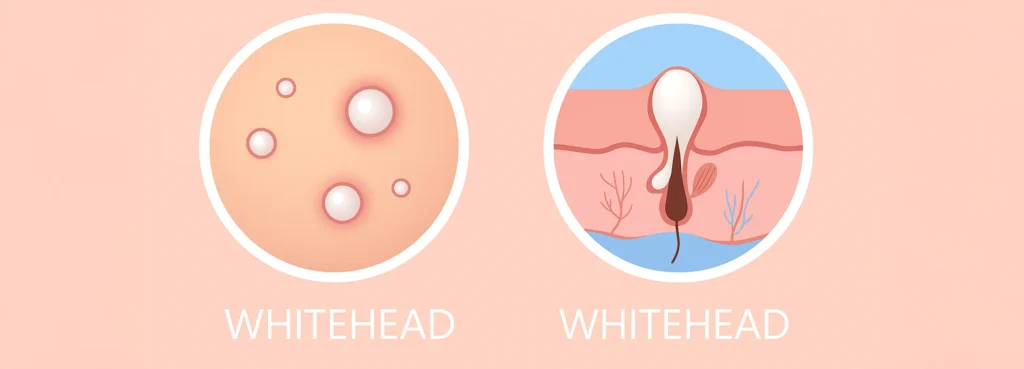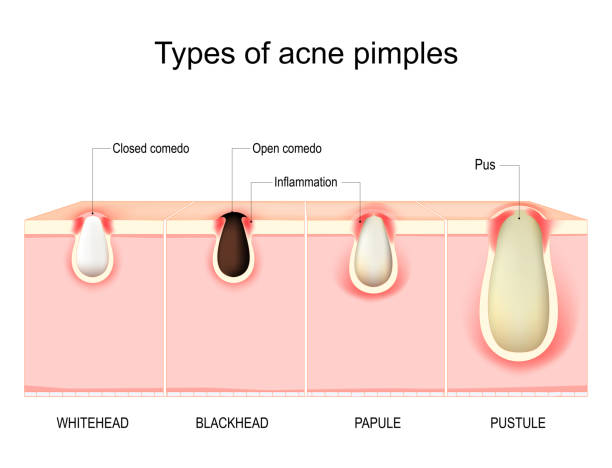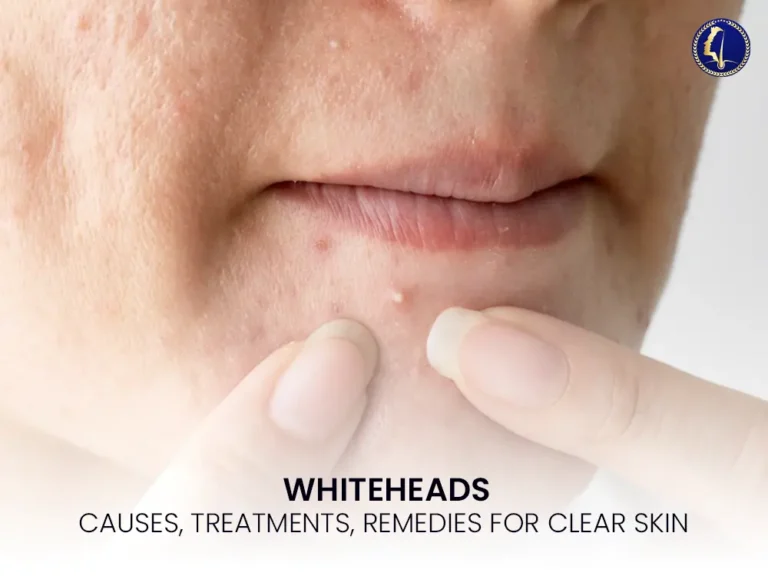What Are Whiteheads?

Whiteheads are a form of acne (acne vulgaris), also known as closed comedones. They pop up when your pores get clogged with sebum (amount of oil), dead skin cells, and other debris.
Whiteheads and blackheads are two different things which blackheads have an open pore, whiteheads have a closed opening, giving them that characteristic white or flesh-colored bump. You’ll often find them on your face, especially on the nose, forehead, and chin.
These pesky tiny bumps can be triggered by hormonal shifts, excess oil production, not enough exfoliation, or certain skincare products. While they’re usually harmless, ignoring them can lead to inflammation, bacterial infections, or even acne scars.
To prevent whiteheads, you can try gentle exfoliation, topical retinoids, salicylic acid, chemical peels, or even professional extractions at a dermatology or aesthetic clinic. Sticking to a consistent skincare routine and opting for non-comedogenic products can really help keep them at bay.
Causes of Whiteheads

1. Excess Sebum (Oil) Production
Hormonal changes, particularly during puberty, menstruation, pregnancy, or stress, can increase oil production and clog pores.
2. Dead Skin Cell Accumulation
If dead skin isn’t exfoliated properly, it mixes with oil and blocks the hair follicle, forming whiteheads.
3. Bacterial Growth
The presence of Propionibacterium acnes bacteria inside clogged pores can worsen inflammation and lead to acne.
4. Hormonal Imbalances
Fluctuations in hormones can cause the sebaceous glands to become overactive, leading to clogged follicles.
5. Pore-Clogging Skincare Products
Using comedogenic (pore-clogging) makeup or skincare can trigger whitehead formation, especially in those with sensitive skin.
6. Diet & Stress
While not the direct cause, high sugar, dairy, or processed foods, combined with elevated stress levels, may worsen whiteheads in some individuals.
Where Do Whiteheads Commonly Appear?

Whiteheads can affect any area with oil glands. Common locations include:
Face (especially nose, chin, forehead)
Chest and back
Upper arms
Buttocks and genitals
These areas are prone to clogged pores due to increased oil production and friction from clothing or hygiene habits.
Are Whiteheads Contagious?
No — whiteheads are not contagious. You cannot spread it through skin-to-skin contact. They are caused by internal factors such as oil production and clogged follicles, not infections or viruses.
How Long Do Whiteheads Last?
With the right skincare routine, most whiteheads resolve within 3 to 7 days. However, without proper treatment or if frequently picked or squeezed, they may persist longer and result in skin irritation or scarring.
Best Whitehead Removal Treatments In Malaysia
Topical Retinoids
Retinoids speed up cell turnover, keeping pores clear and preventing new whiteheads. Studies show adapalene reduces acne lesions by up to 60% in 12 weeks. OTC options like Differin are mild, while tretinoin or tazarotene may require prescriptions for stronger results to treat whiteheads.
Salicylic Acid
A proven beta hydroxy acid, salicylic acid penetrates oil-filled pores to dissolve buildup. Research confirms regular use reduces comedones by 47% within 6 weeks. Found in cleansers, toners, and serums, it’s especially effective for oily or acne-prone skin types.
Benzoyl Peroxide
This gold-standard acne treatment kills Cutibacterium acnes bacteria and calms inflammation. Clinical trials show a 50–70% reduction in acne within 8–12 weeks. Start with 2.5–5% to limit irritation before moving to stronger formulas if needed.
Hydrocolloid Pimple Patches
Hydrocolloid dressings absorb pus, oil, and debris, creating a moist environment that speeds healing. A study found they reduce lesion size within 24 hours. Teens love them for overnight use, and they also protect pimples from picking.
Clay Masks
Rich in minerals, clay absorbs excess sebum and tightens pores. Research on kaolin and bentonite shows they reduce oil by 36% after consistent use. Applying 1–2 times a week helps prevent clogged pores and improves skin clarity over time.
Professional Treatments
Dermatologists or medical aesthetic specialists may recommend:
Laser treatments
Prescription-strength retinoids or oral antibiotics
Home Remedies (Natural Options)
While not substitutes for medical treatments, natural ingredients can support clearer skin:
Tea Tree Oil: Natural antibacterial; use diluted with a carrier oil.
Aloe Vera: Soothes inflammation and redness.
Apple Cider Vinegar: Acts as a natural astringent.
Green Tea: Rich in antioxidants, reduces sebum and soothes skin.
Honey & Cinnamon: Antibacterial blend that calms breakouts.
Prevention Tips
Wash your face twice daily with a gentle cleanser.
Exfoliate 2–3 times a week using chemical exfoliants (like salicylic acid).
Avoid touching your face.
Use non-comedogenic skincare and makeup.
Change pillowcases regularly.
Stay hydrated and eat a skin-friendly diet.
Frequently Asked Questions
1. How do you get rid of whiteheads?
Use gentle exfoliation, salicylic acid, or topical retinoids to clear clogged pores. Professional extraction or chemical peels at an aesthetic clinic can help stubborn cases.
2. What is the main cause of whiteheads?
Whiteheads form when pores are clogged with sebum (oil), dead skin cells, and debris, often triggered by hormonal changes, stress, or certain skincare products.
3. Will whiteheads go away on their own?
Mild whiteheads may clear naturally over time, but persistent ones often require skincare treatments or professional intervention to prevent scarring and new breakouts.
4. Should you squeeze whiteheads?
No. Squeezing can cause inflammation, infection, and acne scars. It’s safer to use proper skincare or seek professional extraction.
When to See a Professional
If whiteheads:
Do not improve with OTC treatments
Appear persistently on the chest, back, or buttocks
Cause emotional distress or affect your confidence
→ It’s time to consult a dermatologist or certified aesthetic doctor. GLOJAS offers expert-led consultations and tailored whitehead solutions in Kuala Lumpur.
Reveal Clear, Smooth Skin with Expert Whitehead Treatment in Malaysia
At GLOJAS Specialist Clinic, we believe that true skin confidence starts with expert care. Whether you’re facing recurring skin issues, looking to refresh your complexion, or want to explore advanced aesthetic treatments, our LCP-certified doctors are here to guide you every step of the way.
Located in the heart of Kuala Lumpur, our clinic combines medical-grade technology with personalized care to deliver results that are safe, natural, and lasting. From clinical consultations to custom skincare solutions, GLOJAS offers a comprehensive approach tailored to your skin’s unique needs.
